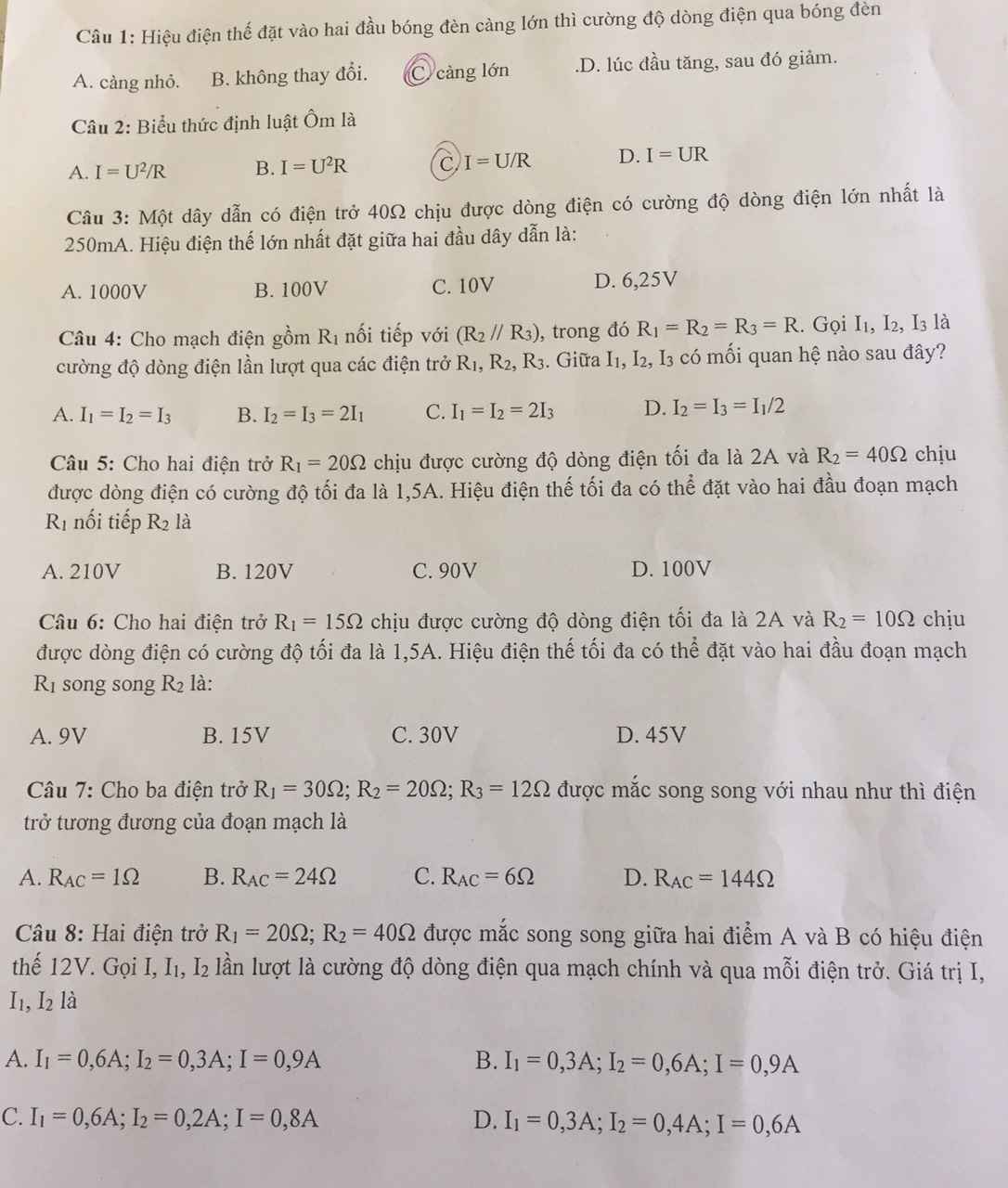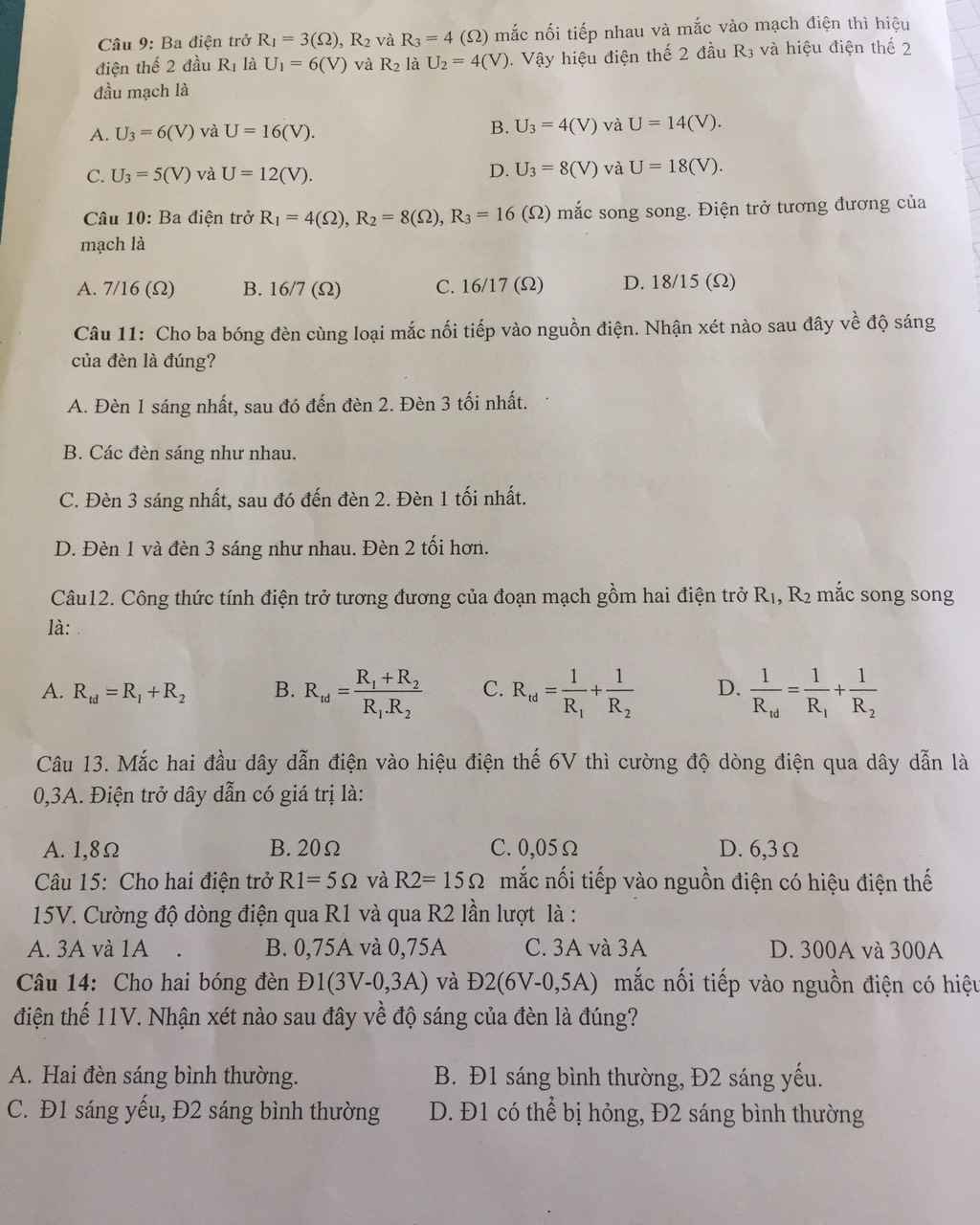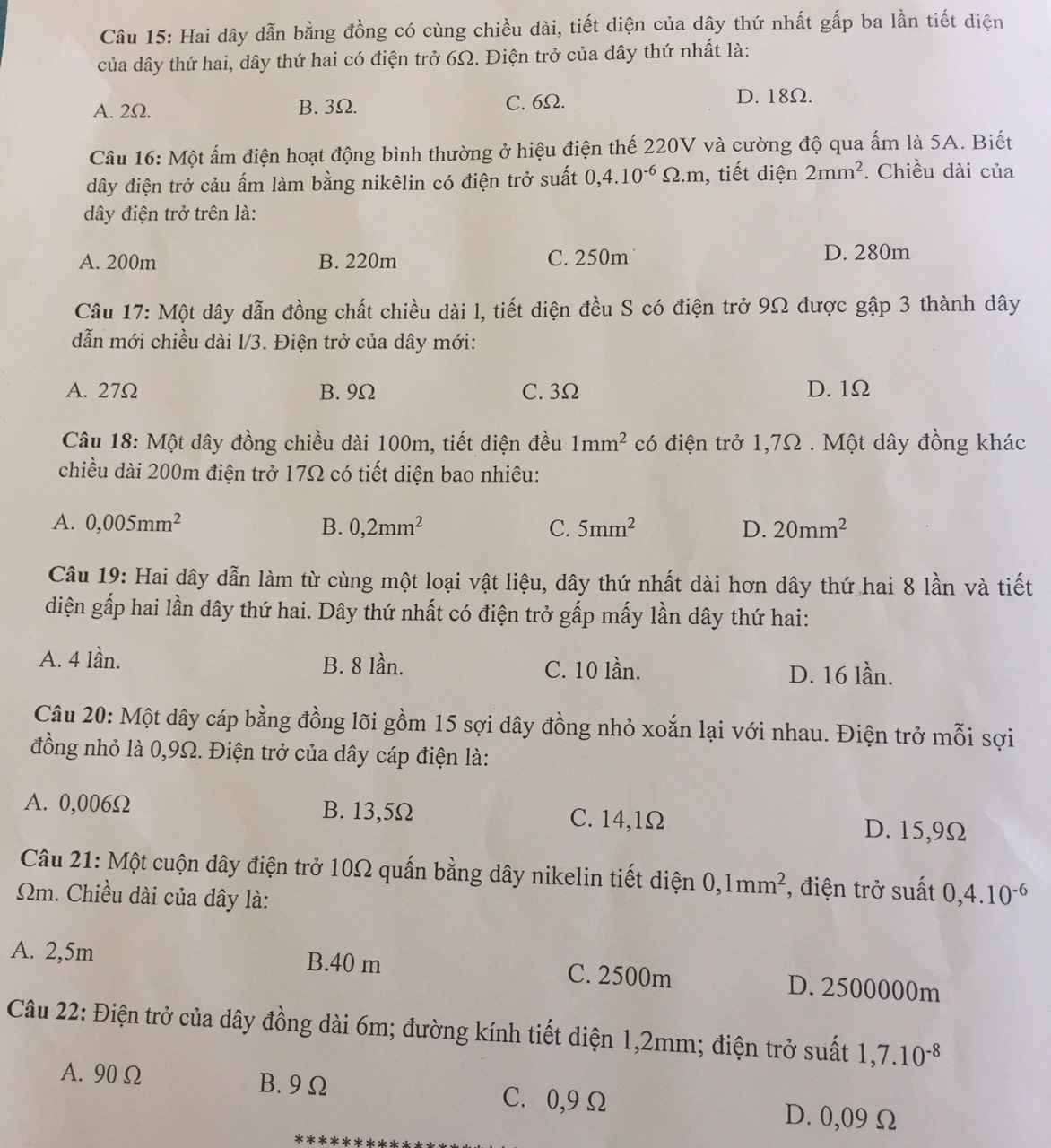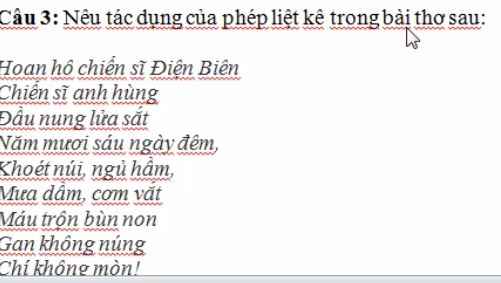Mình cần sự giúp đỡ của mọi người ạ.
Hãy nhập câu hỏi của bạn vào đây, nếu là tài khoản VIP, bạn sẽ được ưu tiên trả lời.


mai bạn tách ra nha để vậy hơi nhiều
c1: theo ct: \(I=\dfrac{U}{R}\)=>U tỉ lệ thuận I =>I càng lớn thì U càng lớn
C2(bn làm đúng)
C3: \(=>Umax=Imax.R=40.\dfrac{250}{1000}=10V\)=>chọn C
c4: R1 nt(R2//R3) =>U2=U3 mà R2=R3=>I2=I3
\(=>I1=I2+I3=>I2=I3=\dfrac{I1}{2}\)
C5: R1 nt R2
mà \(I1=2A,I2=1,5A\)=>chọn I2\(=>I1=I2=Im=1,5A=>Umax=\left(R1+R2\right).1,5=90V\)
C6: R1//R2
\(=>U1=I1R1=30V,U2=I2R2=15V\)=.chọn U2
C7\(=>\dfrac{1}{RTd}=\dfrac{1}{R1}+\dfrac{1}{R2}+\dfrac{1}{R3}=>Rtd=6\left(om\right)\)
C8-\(=>I=\dfrac{U}{\dfrac{R1R2}{R1+R2}}=0,9A\)
\(=>I1=\dfrac{U}{R1}=\dfrac{12}{20}=0,6A=>I2=0,3A\)
C9-\(=>U3=\left(\dfrac{U1}{R1}\right)R3=8V=>Um=U1+U2+U3=....\)
(thay số vào)
C10\(=>\dfrac{1}{Rtd}=\dfrac{1}{R1}+\dfrac{1}{R2}+\dfrac{1}{R3}=>Rtd=......\)(thay số)
C11: các bóng đèn như nhau nên mắc vào chung 1 nguồn điện nối tiếp sẽ hoạt động với đúng cường độ dòng điện định mức nên các bóng đều sáng bth=>chọn B
C12 \(\dfrac{1}{Rtd}=\dfrac{1}{R1}+\dfrac{1}{R2}\)=>chọn D
c13\(=>R=\dfrac{U}{I}=\dfrac{6}{0,3}=20\left(om\right)\)
c14 R1 nt R2
\(R1=\dfrac{3}{0,3}=10\left(om\right),R2=\dfrac{6}{0,5}=12\left(om\right)=>I1=I2=\dfrac{11}{R1+R2}=0,5A=>I1>I\left(đm1\right),I2=I\left(đm2\right)\)
=>đèn 1 sáng mạnh hơn bth có thể hỏng , đèn 2 sáng bth
c15.\(=>\dfrac{R1}{R2}=\dfrac{S2}{S1}=>\dfrac{R1}{6}=\dfrac{1}{3}=>R1=2\left(om\right)\)
c16.\(=>l=\dfrac{RS}{p}=\dfrac{\left(\dfrac{U}{I}\right)S}{p}=\dfrac{\left(\dfrac{220}{5}\right).2.10^{-6}}{0,4.10^{-6}}=220m\)
c17.=>\(S'=3S,=>l'=\dfrac{1}{3}l\)
\(=>\dfrac{R}{R'}=\dfrac{\dfrac{pl}{S}}{\dfrac{pl'}{S'}}=\dfrac{S'.l}{S.l'}=\dfrac{3S.l}{S.\dfrac{1}{3}.l}=9=>R=9R'=>R'=\dfrac{R}{9}=1\left(om\right)\)
c18.chọn dây dẫn R3 có l3=l2,S3=S1,chùng chất liệu đồng
\(=>\dfrac{R1}{R3}=\dfrac{l1}{l3}=>\dfrac{1,7}{R3}=\dfrac{100}{200}=>R3=3,4\left(om\right)\)
\(=>\dfrac{R2}{R3}=\dfrac{S3}{S2}=>\dfrac{17}{3,4}=\dfrac{10^{-6}}{S2}=>S2=2.10^{-7}m^2\)\(=0,2mm^2\)
c19 \(l1=8l2,S1=2S2\)
\(=>\dfrac{R1}{R2}=\dfrac{\dfrac{pl1}{S1}}{\dfrac{.pl2}{S2}}=\dfrac{S2.l1}{S1.l2}=\dfrac{S2.8l2}{2S2.l2}=4=>R1=4R2\)
c20.\(=>R=\dfrac{0,9}{15}=0,06\left(om\right)\)(đáp án đề sai)
c21\(=>l=\dfrac{RS}{p}=\dfrac{10.10^{-7}}{0,4.10^{-6}}=2,5m\)
c22\(=>R=\dfrac{pl}{S}=\dfrac{6.1;7.10^{-8}}{3,14.\left(\dfrac{0,0012}{2}\right)^2}=0,09\left(om\right)\)

?????????????????????????????????????????????????????????????????????????????????????????????????????????????????????????????????????????????????????????????????????????????????????????????????????????????????????????????????????????????????????????????????????????????????????????????????????????????????????????????????????????????????????????????????????????????????????????????????????????????????????????????????????????????????????????????????????????????????????????????????????????????????????????????????????????????????????????????????????????????????????????????????????????????????????????????????????????????????????????????????????????????????????????????????????????????????????????????????????????????????????????????????????????????????????????????????????????????????????????????????????????????????????????????????????????????????????????????????????????????????????????////////////////////////////////////////////////////////////////////////////////////////////////////

Bài 2 :
a) (1) \(CaO+CO_2\rightarrow CaCO_3\)
(2) \(CaO+H_2O\rightarrow Ca\left(OH\right)_2\)
(3) \(Ca\left(OH\right)_2+CO_2\rightarrow CaCO_3+H_2O\)
(4) \(CaCO_3\underrightarrow{t^o}CaO+CO_2\)
(5) \(CaO+2HCl\rightarrow CaCl_2+H_2O\)
Chúc bạn học tốt
b)(1) \(S+O_2\underrightarrow{t^o}SO_2\)
(2) \(2SO_2+O_2\underrightarrow{t^o,V_2O_5}2SO_3\)
(3) \(SO_3+H_2O\rightarrow H_2SO_4\)
(4) \(H_2SO_4+CuO\rightarrow CuSO_4+H_2O\)
(5) \(CuSO_4+2NaOH\rightarrow Cu\left(OH\right)_2+Na_2SO_4\)
(6) \(Cu\left(OH\right)_2\underrightarrow{t^o}CuO+H_2O\)
(7) \(SO_2+2NaOH\rightarrow Na_2SO_3+H_2O\)
Chúc bạn học tốt

Không phải sgk. Sách luyện thêm cô cho làm bt thêm nha!

\(d,ĐK:x\ge1\\ PT\Leftrightarrow\sqrt{x-1}=2+\sqrt{x+1}\\ \Leftrightarrow x-1=2+x+1+4\sqrt{x+1}\\ \Leftrightarrow4\sqrt{x+1}=-4\Leftrightarrow x\in\varnothing\left(4\sqrt{x+1}\ge0\right)\\ g,ĐK:x\ge\dfrac{1}{2}\\ PT\Leftrightarrow x+\sqrt{2x-1}+x-\sqrt{2x-1}+2\sqrt{\left(x+\sqrt{2x-1}\right)\left(x-\sqrt{2x-1}\right)}=2\\ \Leftrightarrow2x+2\sqrt{x^2-2x+1}=2\\ \Leftrightarrow\sqrt{\left(x-1\right)^2}=\dfrac{2-2x}{2}=1-x\\ \Leftrightarrow\left|x-1\right|=1-x\\ \Leftrightarrow\left[{}\begin{matrix}x-1=1-x\left(x\ge1\right)\\x-1=x-1\left(x< 1\right)\end{matrix}\right.\Leftrightarrow\left[{}\begin{matrix}x=1\left(tm\right)\\x\in R\end{matrix}\right.\)




 Mọi
Mọi

1. Who did you have lunch with yesterday?
2. How often does Nam visit his grandparents?
3. What are Mrs.Lan’s children doing in the living room?
4. Why didn’t Lien go to school last Monday?
Câu 5:
Where were you last night ?